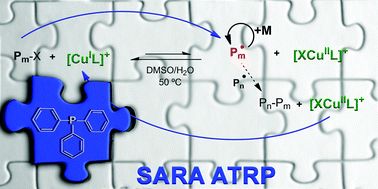Addressing the role of triphenylphosphine in copper catalyzed ATRP†
Abstract
A new Atom Transfer Radical Polymerization (ATRP) process with triphenylphosphine (PPh3) and [CuIIMe6TREN]2+ as the catalyst system is reported. It is shown that PPh3 can act not only as an efficient reducing agent (RA) but also as a supplemental activator (SA). The kinetics and mechanism of SARA ATRP of methyl acrylate (MA) in DMSO and DMSO/H2O (90/10 v/v) were investigated in detail. The polymers presented controlled molecular weight, very low dispersity (Đ ≈ 1.03), and well-defined chain-end functionality. UV-Vis and electrochemical studies were performed to understand the role of PPh3 and the CuIIBr2/Me6TREN complex in MA polymerization. It is demonstrated that the presence of PPh3 does not affect the stability of the [BrCuIIMe6TREN]+ deactivator. The reported results reveal the high versatility of PPh3 in ATRP, which, besides being commonly used in iron-mediated polymerizations, can also be employed as a SARA agent in copper-based ATRP systems.



 Please wait while we load your content...
Please wait while we load your content...